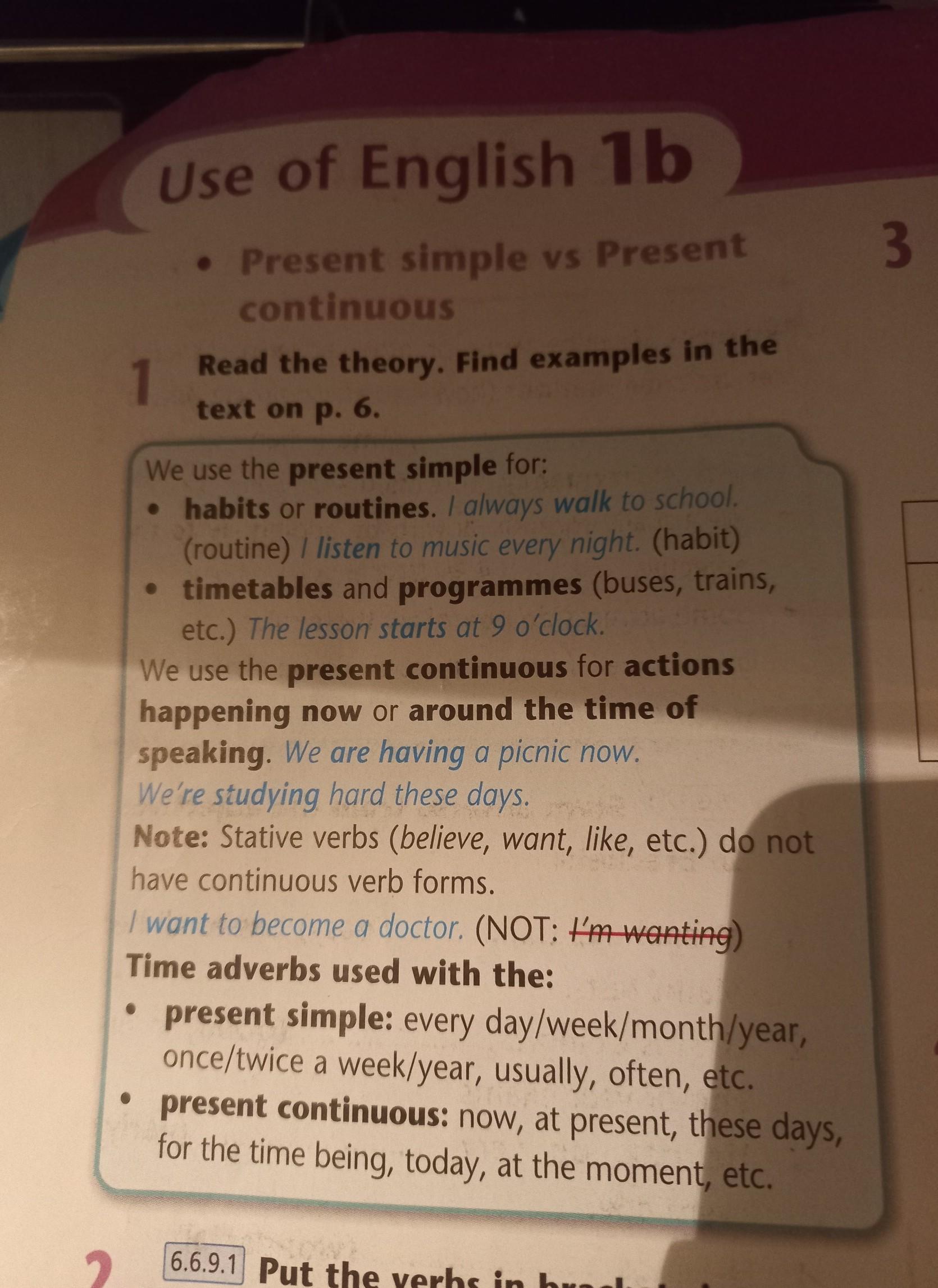-
Read the theory. Find examples in the text on p. 6. 1 We use the present simple for: • habits or routines. I always walk to school. (routine) / listen to music every night. (habit) • timetables and programmes (buses, trains, etc.) The lesson starts at 9 o'clock. We use the present continuous for actions happening now or around the time of speaking. We are having a picnic now. We're studying hard these days. Note: Stative verbs (believe, want, like, etc.) do not have continuous verb forms. I want to become a doctor. (NOT: I'm wanting) Time adverbs used with the: • present simple: every day/week/month/year, once/twice a week/year, usually, often, etc. • present continuous: now, at present, these days, for the time being, today, at the moment, etc.

-
Предмет:
Английский язык -
Автор:
fred70 - 2 года назад
-
Ответы 1
-
Ответ:
The theory states that the present simple is used for habits or routines, as well as for timetables and programs (such as buses and trains). For example, "I always walk to school" illustrates a routine, and "The lesson starts at 9 o'clock" demonstrates the use of present simple for timetables.
On the other hand, the present continuous is used for actions happening around the time of speaking. The examples "We are having a picnic now" and "We're studying hard these days" show the present continuous in action.
It's worth noting that stative verbs like "believe," "want," and "like" do not have continuous verb forms. For instance, "I want to become a doctor" is correct, while "I'm wanting to become a doctor" is not.
Time adverbs also play a role in indicating tense:
- For present simple, adverbs like "every day/week/month/year," "once/twice a week/year," "usually," and "often" are used.
- For present continuous, adverbs like "now," "at present," "these days," "for the time being," "today," and "at the moment" are employed.
-
Автор:
gemaknight - 2 года назад
-
2
-
-
Добавить свой ответ
-
i1) На координатной плоскости начертите треугольник АВС, верши-
ны которого А(2; 5), В(2; 2) и с (6; 2).
2) Постройте треугольник a1, B1, С1, симметричный треугольнику ABC
относительно:
а) координатной оси ОХ;
б) координатной оси ОУ:
в) точки О начала координат.
3) В каждом из случаев запишите координаты вершин треугольника
A1B1C1 .
1 и 2 отдельно
-
Предмет:
Математика -
Автор:
pranav - 2 года назад
-
Ответов:
1 -
Смотреть
-
-
ФОТО РЕШЕНИЯ Доведіть, що парною є функція 3) f(x) = √x2 + 2; 4) f(x) = 1_
x^2
-
Предмет:
Математика -
Автор:
rigoberto - 2 года назад
-
Ответов:
1 -
Смотреть
-
- Какое число в квадрате дает 5
-
Из всех изобретений человечества самое разрушительное - порох - имело наибольшее влияние в политическом, экономическом и научном отношении. Первоначальное изобретение пороха приписывается и ара- бам, и византийским грекам, но, вероятнее всего, он был изобретён в Ки- тае. Секрет его изготовления заключается в том, чтобы, добавляя к углю и сере селитру, приготовить вещество, сгорающее без воздуха. Селитра встречается в природе в некоторых залежах, а также в удобренной земле. Быть может, впервые она случайно была использована при изготовлении ракет для фейерверка или было замечено, что применение её вместо соды (углекислого натрия) в виде плавня с древесным углем вызывало яркую вспышку и лёгкий взрыв. В Китае в течение нескольких столетий она ис- пользовалась только для фейерверков и ракет. ( Вс Поли месе адам келг 8 вуш
-
Предмет:
Русский язык -
Автор:
lam - 2 года назад
-
Ответов:
1 -
Смотреть
-
